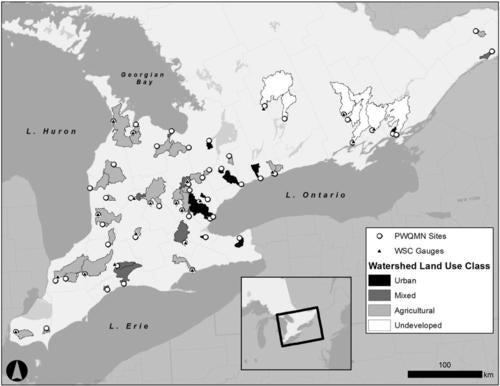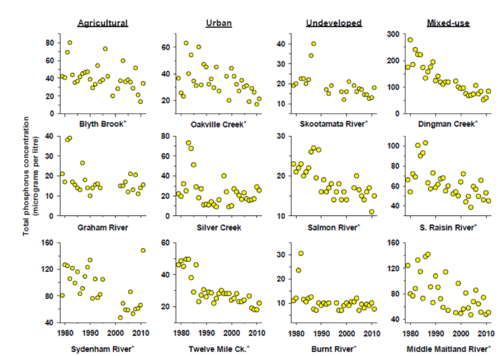Prior to 1970, eutrophication in the Laurentian Great Lakes resulted in algal blooms and nearshore fouling with algae. In response, the Canada-United States Great Lakes Water Quality Agreement (GLWQA) was introduced in 1972 to reduce phosphorus (P) loading to the Great Lakes. The GLWQA required reduction of P exports from wastewater treatment plants and from industrial and diffuse sources. It also limited the amount of P allowed in detergents and specified target P loads for the Great Lakes. Non-point sources of P from agriculture and urban areas were also recognized, and efforts have been made to reduce these inputs.
Following the implementation of the GLWQA, total phosphorus (TP) loads and concentrations in the Great Lakes decreased and improvements in the symptoms of eutrophication were seen until the 1990s. However, algal blooms and fouling are reoccurring, especially in Lake Erie. Climate change, land use changes, legacy P from historical land management practices, and invasive species may all contribute to the reoccurrence of algal blooms.
In Lake Erie, new P loading targets have therefore been set given evidence that the severity of the summer algal bloom is related to the spring input of TP and soluble reactive phosphorus (SRP), the more biologically available form of P. The new target has been set at a further 40% reduction in both TP and SRP spring loads to the western basin of Lake Erie. Trends in TP loads and concentrations have been studied in major Great Lakes tributaries. However, few studies have evaluated these trends in smaller streams where diffuse loading is the major source of P.
In light of the many interventions that have been promoted to mitigate TP losses in both agricultural and urban areas, and the increased interest in non-point sources as drivers of eutrophication, we examined long term trends in growing season (April to November) median TP concentrations using data collected from Ontario streams as part of the Provincial Water Quality Monitoring Network (PWQMN).
Methodology
The PWQMN was established in 1964 and currently includes over 400 active sampling locations throughout the province across various types of landscapes. Many changes have been made to the PWQMN over time: several station locations have changed or were discontinued, sampling regimes have been modified, and laboratory methods have evolved. To ensure that the observed trends were comparable, we used a set of criteria to limit our statistical analyses to samples collected from 56 stations with long, consistent data records with minimal gaps in monitoring (Figure 1). We used a watershed classification approach developed by the United States Geological Survey to identify 29 of the monitoring sites as agricultural, 11 as urban, 7 as undeveloped (but where some forest removal may have occurred), and 9 as mixed-use watersheds.
Several water quality parameters were examined, but the main focus of the study was on P. In particular, we examined trends in TP concentration, which is a measure of all types of phosphorus forms (particulate and dissolved fractions) and is a commonly accepted estimate of the potential of natural waters to experience nutrient-related impacts, in particular eutrophication.
We analyzed trends from 1979-2011. Our analyses were limited to samples collected from April to November, as this period was consistently sampled across several decades. Samples are collected approximately monthly under the PWQMN and typically do not capture high flows like those occurring during the snow melt or after storms. As a result, our analyses represent trends in concentrations (the mass of substances in a given volume of water) in streams and rivers and cannot be used to infer trends in loading (the total mass delivered per unit time) from these watersheds. Water Survey of Canada gauges near selected PWQMN stations provided discharge data for trend analysis and flow weighting. Hence, what these data tell us is how in-stream concentrations during the growing season have been changing over several decades. However, we explored several hypotheses to explain the observed trends in growing season median TP concentration, including those specific to watershed land use and those that are more pervasive across multiple land use types.

Figure 1. PWQMN sites (open circles) and their watersheds used to examine long term trends in annual growing season median total phosphorus concentrations from 1979 to 2011 in Ontario.
Outcomes
The key finding in the study was that TP was declining in 57% of the investigated streams and rivers (32 of the 56 sites). This decline occurred across watershed types (Figure 2). Only one stream in the study showed an increasing trend in TP concentration.
The widespread decline across land use categories suggests that there may be a pervasive cause for the declining trends observed. Pervasive causes may include changes in rainfall composition or timing of runoff. For example, reductions in acid rain may cause less P to be extracted from soils, or changes in the amount of nitrogen relative to P from the atmosphere could cause changes in how much P is lost from watersheds. It is also possible that the drivers differ by watershed type. For example, in forested watersheds, the re-growth of forests after logging could result in lower erosion losses from these watersheds, while improved sewage treatment and land management in urban watersheds and the introduction of best management practices in agricultural watersheds, could result in lower amounts of TP. We used available data and relevant literature to explore the likelihood of these hypotheses.

Figure 2. Examples of trends in total phosphorus in streams and rivers draining watersheds, classified by major land use.
Conclusions
The analysis of the available data demonstrate that stream TP concentration, a major pollutant affecting stream water quality, is decreasing in growing season baseflow conditions in Ontario streams that are not near point sources. If TP export is increasing from these Great Lakes tributaries, it must be during winter or high-flow events. Further work to examine the possible mechanisms in a variety of geographical settings, perhaps over differing time periods, may be needed to establish causes, and to determine if the trends we found in median growing season TP concentration values during spring through fall are also true of annual loadings. To be able to assess water quality trends and loadings to receiving waters, it is critically important that ongoing monitoring aspire to collect continuous and consistent discharge measurements and water quality samples across all seasons and over the full range of discharges, including storm events.
Stammler, K. L., W. D. Taylor, M.N. Mohamed (2017). Long-term decline in stream total phosphorus concentrations: A pervasive pattern in all watershed types in Ontario. Journal of Great Lakes Research 43, 930-937
Contact: William D. Taylor, Department of Biology; Mohamed N. Mohamed, Department of Earth and Environmental Sciences/Ontario Ministry of the Environment
For more information about WaterResearch, contact Amy Geddes.







